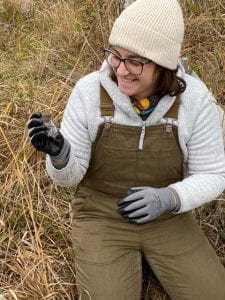Dr. Vera deFerran, Postdoctoral fellow, 2022 – present

I have great interest in ex/in-situ conservation, evolutionary and population genomics, and phylogeography. Although I have always worked with mammals, I am moved by interesting questions, regardless the taxon.
I earned my master’s degree in Ecology and Evolution from the Rio de Janeiro State University (UERJ), Brazil, in 2013. During this period, I studied the biogeography of American marsupials through different biogeographical approaches, both historical and ecological, as well as spatial analysis techniques. In 2021 I finished my Ph.D. which was focused on evolutionary genomics of otters. In my thesis I applied genomic methods to characterize the evolutionary history of otters, using different approaches to investigate a set of relevant problems in this field, such as: (i) phylogenomics, including molecular dating analyses, reconstruction of demographic history and characterization of present-day genomic diversity; (ii) phylogeography; and (iii) identification and characterization of molecular markers (microsatellite loci), generating sets that are recommended for genetic and ecological studies targeting these organisms.
In 2022, after moving to the US, I started this position as a research associate of the Latch Lab as part of the Hawaiian Monk Seal project team. My research now focusses on the development of a SNP panel that will be used to address questions related to migration, inbreeding, and parentage, to assist the species’ conservation management.
Chandika R G, Ph.D. student, 2021 – present
 My research interest revolves around how genomics & GIS can help in wildlife monitoring and conservation. In particular, for my Ph.D., I intend to look at the coding regions in the genome in the North American cervid populations for diseases such as Chronic Wasting Disease.
My research interest revolves around how genomics & GIS can help in wildlife monitoring and conservation. In particular, for my Ph.D., I intend to look at the coding regions in the genome in the North American cervid populations for diseases such as Chronic Wasting Disease.
Before enrolling at UWM, I worked in three different projects at various laboratories in India. My genetics journey began with my Master’s dissertation on landscape genetics of Nilgiri Tahr, an endemic-endangered ungulate in South India. Parallely, I was shown how integrating landscape data could bring out reasons that hinder gene flow between populations. This experience in genetics paved the way to execute a project independently for deducing the genetics of captive-bred Red Panda in Darjeeling Zoo, India and Singalila National Park, India (captive-bred individuals will be restocked in Singalila). My interest to use -omics for conservation developed during this project when the ‘genetic health’ of the population was sought by the conservation managers. We studied the microsatellite diversity of these Red Pandas, and helped to make decision on which individuals could enhance the genetic diversity in this population.
After completing this project, I moved to the Zoological Survey of India in a DST-SERB-funded project that will deduce the phylogeography and colonization history of Indian Rhesus macaque. Though this is a species under Least Concern in IUCN Red List, it has become vermin in many parts of India. Apart from that, its range extension because of human mediated changes in the landscape is posing threat to bonnet macaque which is an endemic species in South India. It will be interesting so see how this project would take shape especially from management perspective.
My leisure activities include reading topics in psychology and permaculture, anything artsy and appreciating good thought-provoking humor. My outdoor hobbies are biking and photography.
Billie Harrison, PhD student, 2022 – present

My research has focused on applying quantitative analysis, GIS and now genomics tools towards the conservation of often maligned taxa like herptiles, fish and invertebrates. I am fortunate to have worked on field research projects from below the sea up to cloud forest heights. For many years, I have been researching the endemic Grenada frog (Pristimantis euphronides) and the introduced Johnstone’s frog (Eleutherodactylus johnstonei) on the island of Grenada. For my Master’s degree, I explored the relationship between the two species and mapped the distribution of the endemic frog. The recent IUCN Lesser Antillean amphibian assessment developed extant range data based on my mapping efforts and updated the status of P. euphronides from “Red List, Endangered” to “Critically Endangered”. After completing this effort, it became clear that still very little is known that can aid in conservation management strategies for this species. For my PhD, I hope to gain a better understanding of how anthropogenic and climate changes might impact diversity and gene flow in this high elevation endemic. I am also very interested in determining occupancy through stratified random sampling efforts.
I was a contributing author on the 2022 Amphibians and Reptiles of Wisconsin guide book and served as the Outreach Coordinator for the Eastern Massasauga Rattlesnake Species Survival Planning group. As coordinator of the Outreach team, I strive to inspire citizens to make responsible choices that benefit our communities by protecting the natural places upon which we rely.
In my free time, I enjoy being outside and going on ridiculously long runs. I then enjoy boring my husband, family and friends by talking endlessly about herptiles, invertebrates and fish. After I’ve strained my human relationships enough, I turn to caring for my herptiles, invertebrates and dog who register no complaints when I watch slow-paced films and play, or attempt to play different musical instruments.
Madeline Opie, M.S. student, 2021 – present

My research focuses on the use of genetics to improve conservation efforts of threatened species. Specifically, determining the most effective method for genetic species identification between Wisconsin’s three Microtus voles. All three species have similar morphology and an overlap in habitat distribution and preference. For these reasons, it’s difficult to identify the species using traditional field identification methods. To improve the Wisconsin Department of Natural Resource’s conservation efforts for the two threatened species, (M. ochrogaster and M. pennsylvanicus) we’re working to evaluate two approaches to genetic species identification: a length polymorphism in the avrpr1a gene and sequence polymorphisms in the COI gene. We are evaluating our methods using tissue and less invasive samples (whisker, fur, and fecal) to minimize the need for handling animals in the field.
Born and raised in Wisconsin, I earned my Bachelor’s degree in environmental sciences and studies from UW – Madison in 2018. After my undergraduate career I worked a few seasons in and out of Wisconsin. I worked as an outdoor field instructor in the Northwoods of Wisconsin and a trail builder for the National Parks Service on Isle Royale, Michigan. Prior to the beginning of the pandemic I worked as a Forest Service park ranger in Juneau, Alaska at the Mendenhall Glacier Visitor Center. During the pandemic I worked for the Wisconsin Department of Natural Resources as an Environmental Program Associate in the Remediation and Redevelopment program. I worked in database management for spill and underground storage tank clean up in the Southeast region of the state.
In addition to school, I work as an ecologist intern for GEI, an environmental consulting company. Through a combination of fieldwork, data analysis, and GIS we focus on habitat restoration, wetland delineations, and endangered species surveys. I’ve been involved with the dredging of contaminated soils in the Milwaukee River, wetland habitat restoration in the Northwoods of Wisconsin, and various wetland delineations for the Wisconsin Department of Transportation and private entities.
